If you’ve plenty of time for your Scottish motorhome holiday, the beaches of northern Scotland have lots to offer: clean white sand, spectacular views, whale-watching opportunities, great surf and very few people. You do have to be a bit dedicated to get there, but it’s worth it.
One thing you need to be prepared for is how narrow many of the roads are. Often they’re single-track with passing places, and you will have to reverse if you meet another vehicle coming towards you. Our motorhomes are fitted with rear view cameras to make the job easier for you.
It’s also good manners to pull over when it’s safe and let faster vehicles overtake you: you wouldn’t want to be the person who stopped the doctor reaching a patient in need. And please bear in mind that passing places are exactly that. They’re not there for admiring the scenery or making a leisurely cup of tea (yes, people do…!).
Another thing to bear in mind is that you’ll be following much of the North Coast 500 route so it would be wise to book campsites in advance, especially during school holidays.
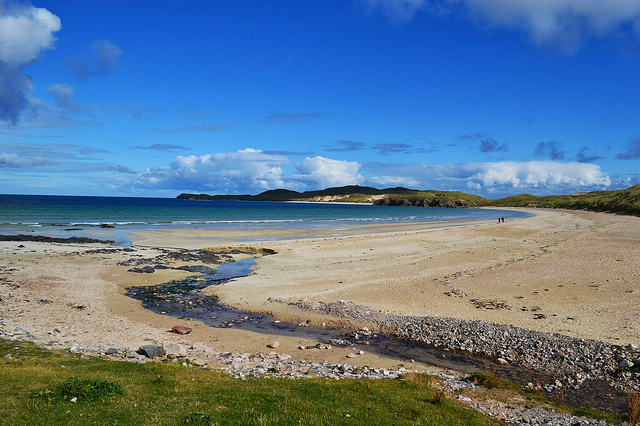
Motorhome Route along the North East coast
OK, now the “housekeeping” is out of the way, it’s time to enjoy your beach holiday! We’ll start at Inverness, gateway to the Highlands.
Once you’ve crossed the Moray Firth on the Kessock Bridge, follow signs for the Black Isle. There’s nothing nasty about the place: it’s far more green than black. The name apparently comes from the fact that this peninsula is so warm that the snow doesn’t lie, so it looked black against the snowy Highland mountains to people viewing it from the south.
Your first port of call is Fortrose, which has beaches either side of a spit of land that reaches out into the Moray Firth. The sand and shingle beaches are very popular with walkers and whale- and dolphin-watchers – this is one of the best places in the UK to spot them. At the end of the land-spit there’s a lighthouse, now privately owned, and you can see Fort George easily across the narrow neck of the Firth.
There’s a campsite at Fortrose, which is probably the best place to park while you explore the beach and the small but pleasant town. If you want to see more of the Black Isle (and it’s worth a look), continue your journey to Cromarty, a friendly town with another long sandy beach and plenty of shops and museums to explore.
Whether you’re coming from Fortrose or Cromarty, you get back onto the A9 at the Culbokie Bridge. Turn off it after Kildary to Portmahomack, a small sheltered harbour and beach on the west side of Tarbat Ness. It’s a great place for sunsets, walking and water-sports, and there’s a small, friendly caravan site right on the shore of the Dornoch Firth. This area was important to both the Picts and the Vikings; find out more at the Tarbat Discovery Centre.
North of the Dornoch Firth
To reach the other side of the Dornoch Firth you pass through Glenmorangie (of whisky fame). You can stay at Dornoch Caravan Park, or a bit further up the coast there’s another, rejoicing in the name of Grannie’s Hielan’ Hame Holiday Park, near Embo Beach.
The sands here are white and run for miles – plenty of space for dogs, sandcastles, kites and beach cricket. There’s good sea-fishing and wind-surfing, too, and it’s a great place for kayaking. Dornoch Beach has toilets and disabled facilities.
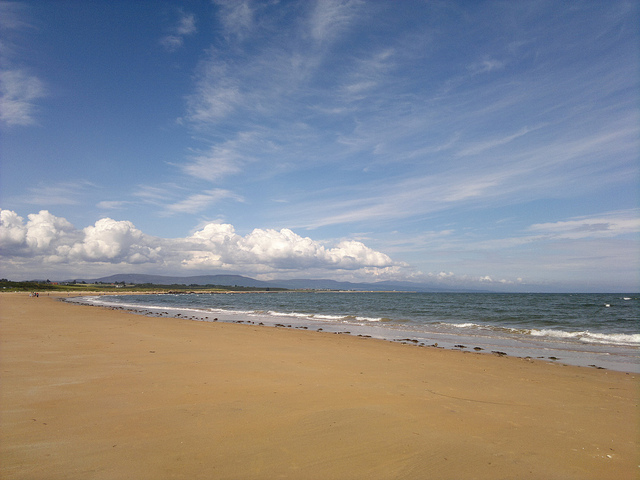
As you drive on up the coast, you’ll pass Dunrobin Castle, which is open to the public. As well as the castle itself, Dunrobin has wonderful gardens and hosts falconry displays.
A hidden gem of a beach can be found behind the golf course at Brora, another great surfing centre – the surf gets so high here sometimes that it closes the harbour. The beach is wild, mainly sandy and a good place to watch out for otters, dolphins, heron and Arctic tern. Fossils of older wildlife have been found at the mouth of the river and seals bask on the rocks at the southern end of the beach. You can park at the golf club, where you’ll also find toilets and a café.
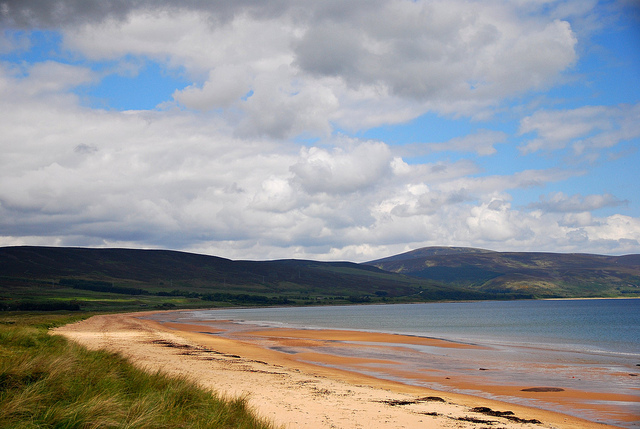
And now for something rather different: Crakaig Beach, mainland Scotland’s only official nudist beach. Only the western part of the beach is for naturists; you can keep your clothes on elsewhere and may prefer to, given the normal temperatures up here! Behind the beach is a campsite which may be reserved for naturists a few weeks of the year but is open to everyone the rest of the time.
Discover the cliffs and stacks
From Helmsdale northwards there’s little in the way of beaches until you reach Sinclair’s Bay, just north of Wick. There are very fine cliffs and small fishing villages, but not much sand, though there is an outdoor swimming pool among the rocks at Wick. Sinclair’s Bay bucks the trend, with about 5 miles of sand between Noss Head and Tang Head.
The southerly, more sheltered, part of the bay is known as Reiss beach and the northern part as Keiss beach, and both are listed in almost every compilation of Scotland’s best beaches. You may see surfers and kite-surfers here but swimming is not recommended as the water’s too cold.
At Reiss beach there’s a car park opposite the golf course and you can walk south along the white sand to Ackergill Tower (now a hotel), the ruins of Sinclair Castle and a former lighthouse.
Keiss has a small harbour as well as its wildly beautiful strand. It’s rockier than Reiss beach and less popular, which makes it a great wildlife-watching spot. Orca have been spotted but you’re more likely to see seals and a range of sea-birds. At the northern end of the beach are the ruins of Keiss Castle; you can also see the remains of Second World War defences dotted about.
The north-east point of Scotland is, again, rocky and high – this is not a good place for vertigo sufferers. Just off the headland you’ll see the Stacks of Duncansby, which used to be attached to the mainland. The sea batters against them and will one day overpower them, but for the moment they provide a spectacular photo opportunity.
The furthest north of the Scottish mainland
Just round the point is John o’ Groats, with views across to the Orkneys but no beaches. You have to wait until Dunnet Bay and Thurso Bay to find them again (you’ll also find caravan sites at both places).
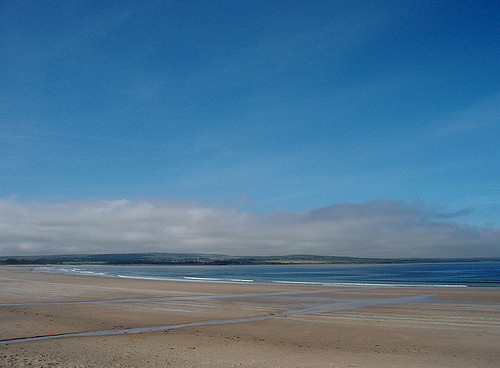
At Thurso, sand is mixed with rock and underwater reefs stretch out sea, creating some of the best surfing in Britain, if not the world – and very little competition for the hardy souls who ride it. There’s plenty of parking in Thurso, plus pubs, toilets and shops. From Scrabster, a mile further on, you can take a day-trip across to Stromness on Orkney’s Mainland.
Heading west, Strathy Bay is a wide sandy beach enclosed by cliffs and hills and has plenty of caves for kids – and adults – to explore. Another good surfing beach, it’s also popular with walkers, but dogs are banned during the summer. At Strathy East there are toilets, an information point and a car park, from which you walk over a small hill to reach the beach. The local pub, the Strathy Inn, does food (including a children’s menu).
If there’s one campsite you really have to visit on this trip, it’s Sango Sands at Durness; it has an indefinable quality that draws people back time after time. Maybe it’s the fact that in June you can watch the sand set and rise within about half an hour and in almost the same place.
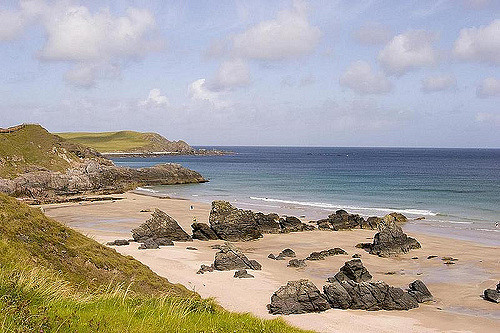
The campsite stands above Sango Bay, a stretch of golden sands separated into three parts by rocky outcrops. There are also sea-stacks, skerries (small rocky islands) and cliffs, and patches of dune and machair (low-lying grassland with wildflowers).
In the next bay to the east of Sango you’ll find Smoo Cave. It’s not a beach but it’s definitely on the “50 things to see in Scotland” list. Not only does Smoo have the largest sea-cave entrance in Britain, it’s also the only cave complex formed by both fresh and sea water. You can walk down into it from the car park and wander round by yourselves for free, or take a guided tour (£5/adult, £2/child). Part of the tour is by boat, the rest is on foot and you’ll need sturdy footwear; they don’t run if it’s raining hard as the cave can flood.
Slightly harder to reach than Sango, and therefore less popular, is Balnakiel Bay, where you may well meet cattle grazing. From Durness you can reach it by walking round Faraid Head, with views all the way to Iceland (and, often, a wind to match). If you’re feeling less energetic, you can follow the track from Durness to Balnakiel. It’s a beautiful sandy beach, protected from the north and east by low-lying headlands.
Westward ho!
Sandwood Sands, down the west coast from Cape Wrath, requires real dedication to reach: it’s a 4-mile walk from the nearest road. It’s worth the effort, though: some people think it’s Britain’s finest beach.
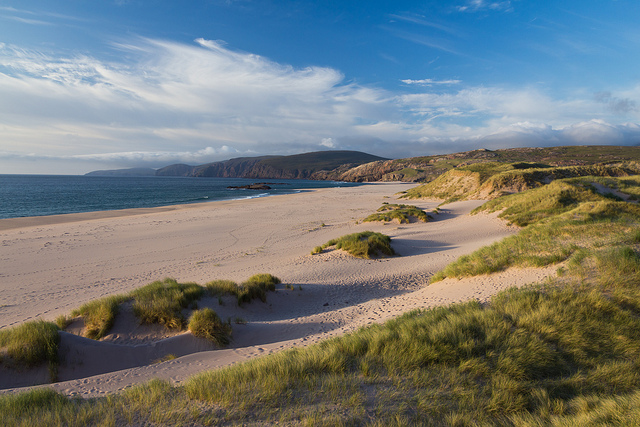
To reach it from Durness, take the A838 south to Rhiconich and turn right along the north side of Loch Inchard. Park at Blairmore and follow the signs. You arrive, via a track across moorland, at a scene of golden sand, dunes, cliffs and a huge sea-stack (known as Am Buachaille, the herdsman). There’s hardly another visitor to be seen, and plenty of space to avoid any. There’s also a fresh-water loch just behind the beach.
Head back to Rhiconish, down to Laxford Bridge, and turn right onto the A894 to reach Scourie, a beautifully protected bay and village. There’s a campsite with spectacular views of the sunset, long beach, blue sea and plentiful wildlife. You could take a boat from nearby Tarbet out to Handa, an island nature reserve famous for its seabird colonies, relax at the pub, or just take a gentle stroll along the sand.
South of Scourie, on the Ullapool road, you’ll find the North West Highlands Geocentre, which explains the extraordinary geology of this part of Scotland – the rocks around here are some of the oldest in the world.
Beaches of the wild west
Don’t be tempted to reach your next destination by the coast road. The route via Drumbeg and Clashnessie may be spectacular but it’s dodgy enough in a car; it’s definitely not designed for motorhomes. Follow the main road from Unapool (not to be confused with Ullapool) to Skiag Bridge and turn right towards Lochinver, then right again and over the hill to Rhicarn, before turning left to Achmelvich.
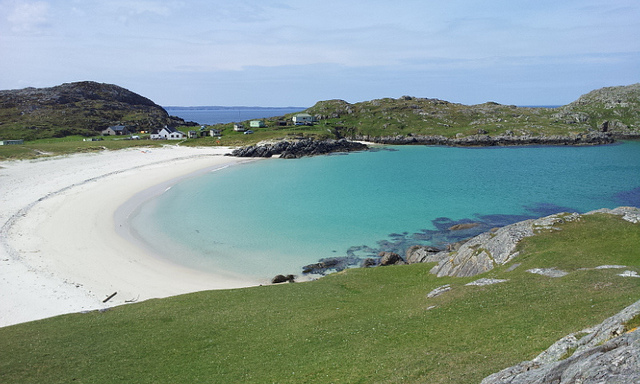
Achmelvich Bay is a beach that many people rave about and, unlike the north coast beaches, that means they go there in quite large numbers. There’s a beach-side campsite that’s very popular with families, so it does get booked up during school holidays; no dogs are allowed. There are no fixed pitches, so you can choose where you park up. The bay is used for all sorts of water-sports, including snorkelling – the water is crystal-clear and the rocky headlands harbour plenty of underwater wildlife.
By water it’s only a few miles to your next stop; by road it’s a good deal further. Go back to Skiag Bridge, down to Ledmore and then right on the A835 to Drumrunie, where you turn right on a tiny road, past Lochs Lurgainn, Bad a’ Ghaill and Osgaig, to Achnahaird Bay.
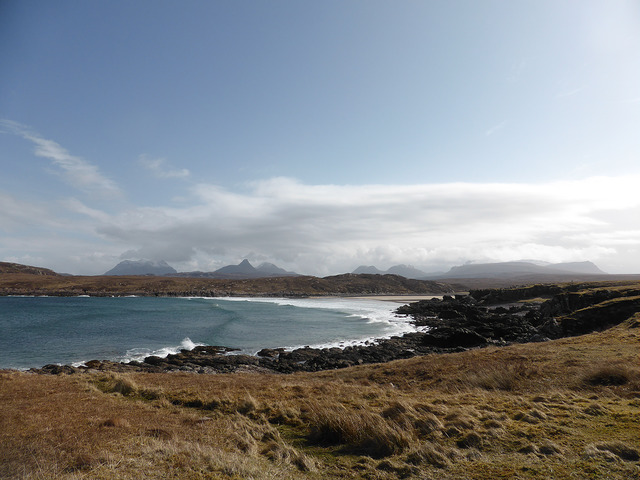
At Achnahaird you’re well and truly in the wilderness, a fitting finale to your tour of Scotland’s best northern beaches. It’s a grand place to build a driftwood fire and have a last-night picnic dinner on the sand (make the fire good and smoky to deter the midges!). You can wild-camp here – there’s no official camp-site and it’s unlikely the few local residents will object, as long as you clean up behind yourselves.
To end your tour, go back to Drumrunie and turn right to Armair and Ullapool, where you pick up the A835 and follow it back to Inverness. If you want more sand and sea before you return your motorhome, see our posts on the west coast and east coast beaches to take you south from here. If you’re heading straight back south, the A9 will take you there via Perth.